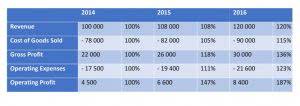
You’ll also need to keep the records of these transactions, such as sales receipts or customer invoices. A very simple general ledger entry to look at as a T-account example is the sale of goods. If John, who has a line of skin care products, sells $5,000 worth of products, he’ll credit (or decrease) his inventory the full $5,000.
What is the approximate value of your cash savings and other investments?
Well, don’t take our word for it – give the software a try out yourself. This feature allows you to focus on specific dimensions and gain insightful knowledge regarding the financial health of your business. Company XYZ provides and collects $4,000 worth of repair services. A financial professional will offer guidance based on the information provided and offer a no-obligation call to better understand your situation. At Finance Strategists, we partner with financial experts to ensure the accuracy of our financial content.
Bookkeeping Journal Entry
Note that this example has only one debit account and one credit account, which is considered a simple entry. A compound entry is when there is more than one account listed under the debit and/or credit column of a journal entry (as seen in the following). Well organized T accounts are the first step in the bookkeeping and accounting process. If they are inaccurate or hard to follow, then everything from drafting financial statements to forecasting future revenue growth is in jeopardy. By recording the debit and credit halves of the transaction and then running a trial balance, the accountant can be sure that nothing has been missed. If the books don’t balance, then something is wrong, and they need to go find it.
Time Value of Money
Importantly, one would not use T-accounts for actually maintaining the accounts of a business. Instead, they are just a quick and simple way to figure out how a small number of transactions and events will impact a company. T-accounts would quickly become unwieldy in an enlarged business setting.

T-accounts can be created for each account your business has, from assets to inventory to owner’s equity. Having T-accounts for each category helps you create a balance sheet or summary of your finances without the stress or hassle of digging through your records and receipts. T-accounts help you keep a clear image of your finances by showing in a very simple and visual fashion just how your credits and debits balance out (a key part of double-entry bookkeeping). Accountants and bookkeepers often utilize T-accounts to make the double-entry accounting system of bookkeeping easier to manage — and you can, too.
Double Entry Bookkeeping

Debits and credits can represent an increase or decrease in separate accounts, but by convention, in a T account, the debit is always on the left side, and the credit is always on the right side. In the company’s books, these transactions are documented as journal entries. These entries are recorded as journal entries in the company’s books. The journal entry recorded in the general journal (as opposed to the sales journal, cash journal, etc.).
Resources for Your Growing Business
t accounts always follow the same structure to record entries – with “debits” on the left, and “credits” on the right. T-accounts are essential for guaranteeing the dependability and correctness of financial data since they systematically record transactions. They provide a solid basis for sound decision-making, enabling stakeholders to evaluate a company’s financial performance and situation confidently. They make it easier for accountants to prepare financial statements and analyze an organization’s financial health by allowing them to monitor changes in each account over time. Debits to revenue and gains can reduce the account balance, while credits increase it.

T Accounts allows businesses that use double entry to distinguish easily between those debits and credits. A T-Account records the debits and credits that affect an account, as well as the running balance of the account. T-accounts are also used for income statement accounts to represent revenues, gains, expenses, and losses on the income statement. Using T Accounts, tracking multiple journal entries within a certain period of time becomes much easier.
- This way you can trace each balance back to the journal entry in the general journal if you have any questions later in the accounting cycle.
- Later, you’ll gather the current data from each journal and add it to your general ledger.
- In order to keep track of transactions, I like to number each journal entry as its debit and credit is added to the T-accounts.
- A T account (or general ledger account) is a graphical representation of a general ledger account.
- Certain types of accounts increase when they are debited and decrease when they are credited.
- A summary showing the T-accounts for Printing Plus is presented in Figure 3.10.
- A very simple general ledger entry to look at as a T-account example is the sale of goods.
11 Financial is a registered investment adviser located in Lufkin, Texas. 11 Financial may only transact business in those states in which it is registered, or qualifies for an exemption or exclusion from registration requirements. A T-account can have many different types of transactions within it but they must always follow this same basic format. Get instant access to lessons taught by experienced private equity pros and bulge bracket investment bankers including financial statement modeling, DCF, M&A, LBO, Comps and Excel Modeling.
” Thanks to his two T-accounts, I have never forgotten to consider the full impact of business transactions. A T Account is the visual structure used in double entry bookkeeping to keep debits and credits separated. For example, on a T-chart, debits are listed to the left of the vertical line while credits are listed on the right side of the vertical line making the company’s general ledger easier to read.
Laisser un commentaire